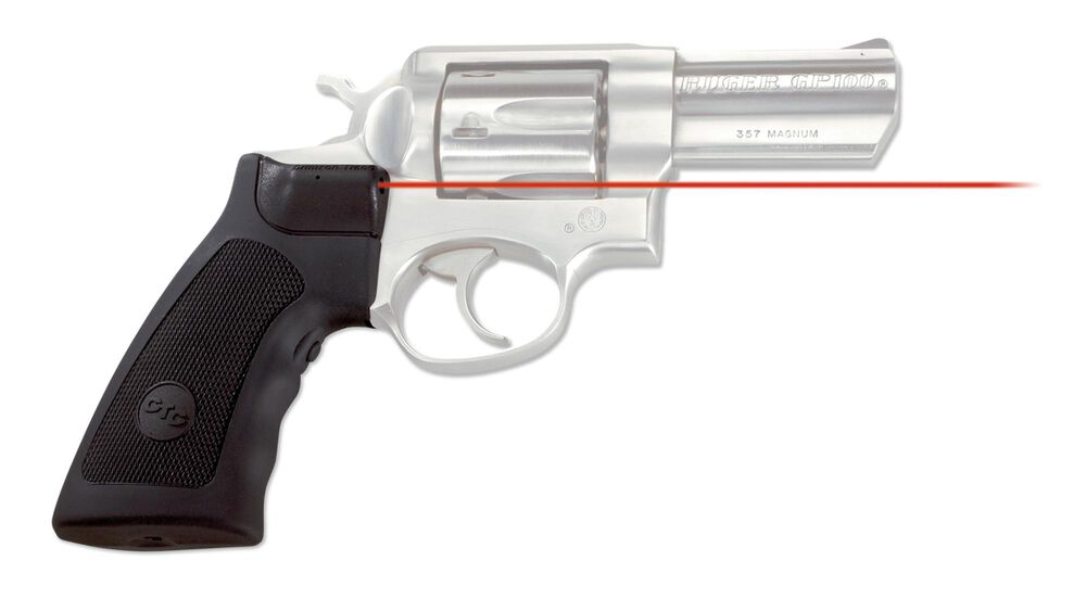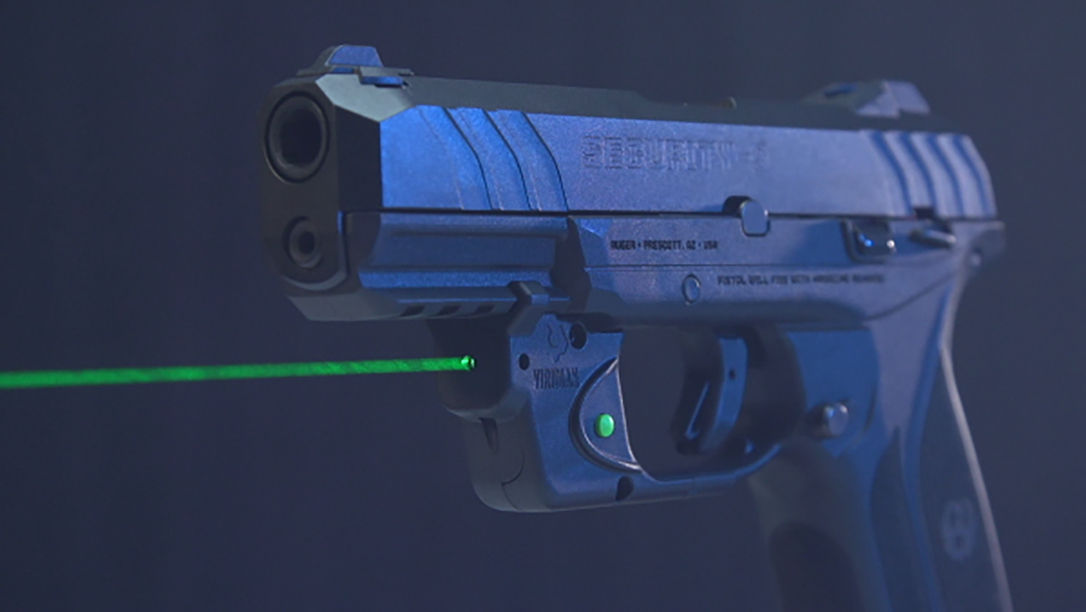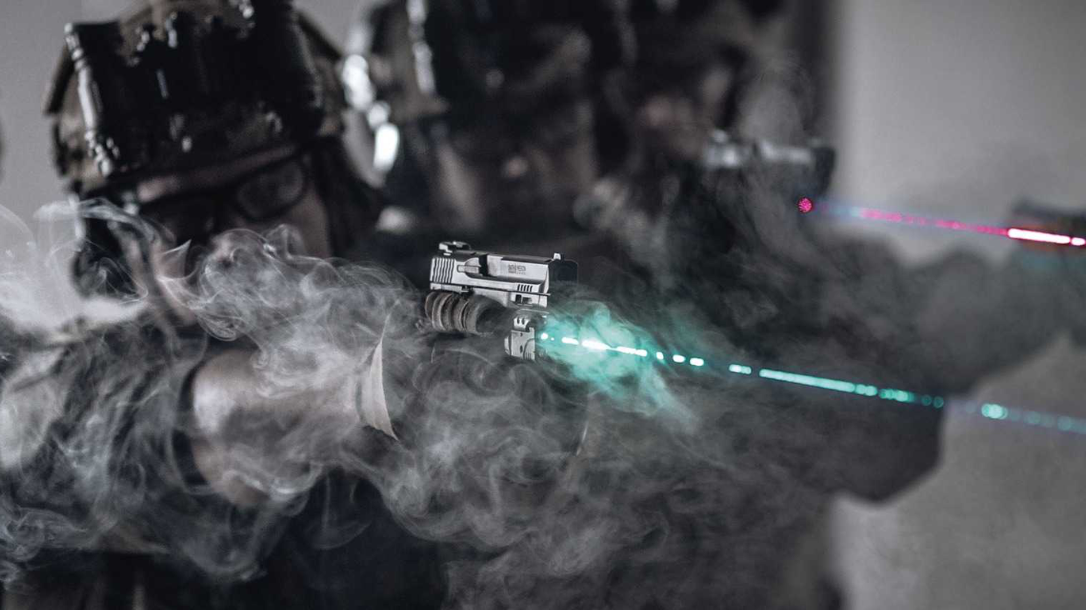I saw a post on Facebook the other day by a Gen Z gun owner talking about how no one should use a laser sight for home defense or self defense. It blew my mind, because I realized that in my lifetime we’ve gone from weapon mounted lasers being highly regarded by serious professionals to being viewed as fudd-tier garbage. How did that happen?
A Brief Look into the Past of the Laser Sight
Visible laser sighting systems have been around for a really long time. The first time a lot of people saw a laser sight would have been in the first Terminator movie in 1984. Laser Products Corporation, which later became Surefire, custom-made the laser fitted to the 1911 used by the Terminator.
Obviously, the military was developing laser technology for all sorts of uses. On the civilian/concealed carry side, the biggest driver of laser technology was Crimson Trace. Crimson Trace started business in 1994. Eventually they launched their product that changed the defensive laser sights market: the Crimson Trace Lasergrips. By this time Surefire had become Surefire, and was also producing laser aiming devices. But the Lasergrips were the most influential product for civilian consumers.
Advertisement — Continue Reading Below
Visible Laser Sights in the Early Global War on Terror
Fast forward a few years and it’s the mid 2000s. The GWOT is in full swing. Very serious people who shoot bad people in the face professionally at attaching Crimson Trace Lasergrips to their M9s and Sig P-series pistols. The Crimson Trace laser sight designed for J-frames allows shooters to make far more precise hits in compromised lighting conditions than regular small revolver sights.

In 2008 I get invited to a media event sponsored by Crimson Trace to demonstrate the utility of Lasergrips in a civilian context. Taught by professional shooter Todd Jarrett, I’ll say that it worked. I certainly understood that in certain contexts, a laser sight made sense.
Advertisement — Continue Reading Below
What Advantages Do Visible Laser Sights Have?
Interestingly, a visible laser aiming device has many of the same advantages as a mini-red dot sight (RDS). It allows the user to utilize target focus aiming. In side by side tests, users with lasers have faster first hits and more precise shot groups than users with just iron sights.
That’s not to say that a laser doesn’t have drawbacks. The greatest drawback is that lasers aren’t visible in all lighting conditions. Outdoors in direct sunlight, many visible lasers are hard to see. The advances in green laser technology help this somewhat. However, a visible laser will be inferior to a red dot sight in direct light.
So What Happened?
But if visible lasers, and especially the Crimson Trace Lasergrips were so good, what happened? How is that if you post about your new laser aiming device on your defensive firearm, people will tell you that lasers are pointless fudd-garbage?
Advertisement — Continue Reading Below
Two things, I think. The first is that the technological development on red dot sights outpaced visible lasers significantly. If you buy a Beretta 92 and put Lasergrips on it, those grips are pretty similar to the ones you could have bought in 2009. Red dot sights have gone through a revolution and are reliable, plentiful, and easily understood. And as mentioned above, the drawback of losing the laser sight in bright light isn’t a concern with a decent red dot sight.
The second thing that happened was that lasers became the victims of their own marketing success. People would buy a laser sight, regardless of the brand because they believed it would fix their fundamental marksmanship problems. For instance, I was in a class around 2011 where the gentleman on the line next to me had some kind of micro-compact 1911 clone and an off-brand Chinesium laser. Each string of fire he’d center the laser on the target, and then FLINCH so hard you could see the dot drag itself low-left before the gun went off. He couldn’t understand why the “laser didn’t work” because he didn’t have the marksmanship skills to realize he had a wicked flinch.
As a result, the current generation of gun owners has entered a space where defensive handguns have mature red dot sight technology. Meanwhile, visible laser sights are associated with a lack of fundamentals and poor quality guns.
Advertisement — Continue Reading Below
Using a Laser Sight for Home Defense

Are laser sights good for home defense? Yes, they’re fine. Let’s list some of the benefits again in case you missed them. A laser allows you, the shooter, to keep your eyes on the threat. Lasers allows for faster target acquisition and faster follow up shots. It allows you to fire accurate shots in diminished lighting conditions. It also allows you to fire accurate shots if you’re in a position where you can’t see the sights, like laying on your side.
Here are somethings lasers won’t do. First and foremost, a handgun laser, just like a red dot sight, will not fix fundamental flaws in your marksmanship. If you flinch, if you have a bad grip and no recoil control, a laser won’t fix that. Secondly, a laser won’t “give away your position” in a home invasion. Unless Navy SEALs are sneaking through your house, you yelling “I have a gun and I’m calling the cops” should have already given away your position. Third, a laser won’t scare your target away. If you believe that, you probably believe that the sound of a pump action shotgun scares bad guys into pooping their pants. It doesn’t.
Advertisement — Continue Reading Below
Lastly, a laser won’t ID your target. It doesn’t cast enough light to be a substitution for turning the lights on, or using a white light. Plus, if your laser is on something, that means your gun is pointing at it. I’m pretty sure there’s something in the 4 Rules about not pointing guns at stuff you don’t want to kill.
Lasers are Still Viable
There are quality laser products on the market, and as mentioned they do offer advantages. In my opinion, they’re best employed on guns that for various reasons cannot mount a red dot sight. Small revolvers and other types of small frame pistol, 1911s, many Berettas, etc are all perfectly reasonable platforms for products like the Crimson Trace Lasergrip. Surefire’s combo light/laser products are also excellent choices, albeit a bit more bulky than the Lasergrip.
I recognize that this article is a little bit “old man yells at clouds.” However, I was shocked to discover that an entire generation of up and coming gun owners had no idea about the work that went into developing visible laser sights, or their benefits for shooters in many situations.
Advertisement — Continue Reading Below
























